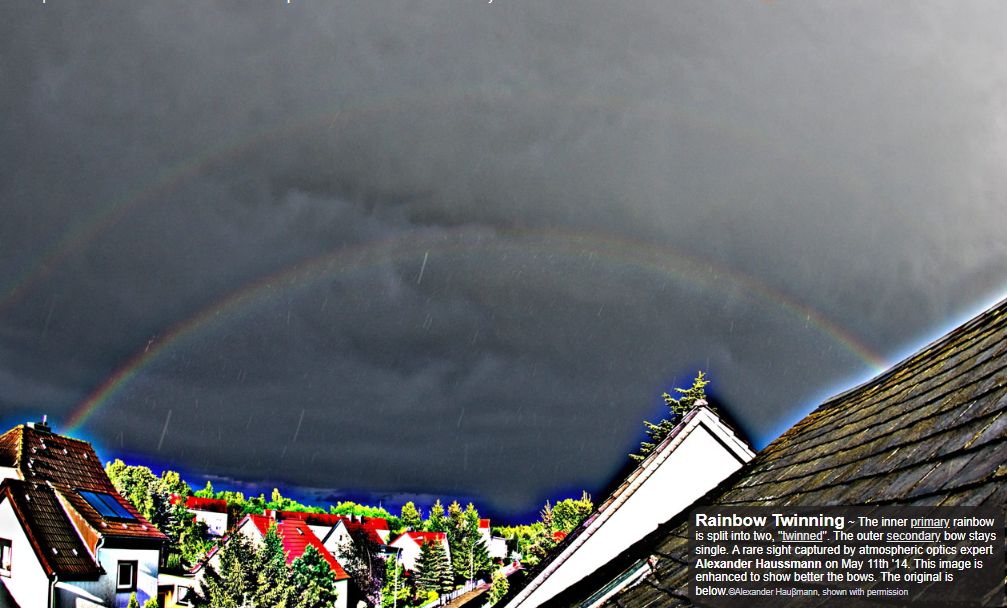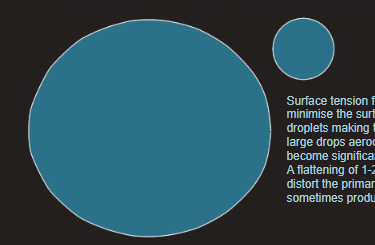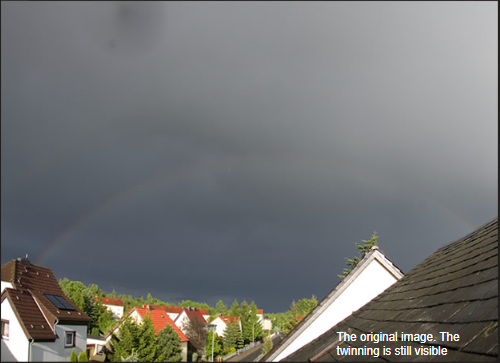Twinned Rainbows - OPOD
Twinned Rainbows - A Rare and Phenomenal Atmospheric Optics Sight
Rainbows are a breathtaking natural phenomenon that never fails to captivate us. But have you ever heard of twinned rainbows? Twinned rainbows are an incredibly rare and exceptional sight, where the inner primary rainbow splits into two distinct bows while the outer secondary bow remains single. This captivating phenomenon was captured by the talented atmospheric optics expert, Alexander Haussmann, on May 11th, 2014. Let's delve deeper into the fascinating world of twinned rainbows and uncover the science behind this extraordinary occurrence.
The Enigmatic Twinned Rainbows
Alexander Haussmann's encounter with his first twinned rainbow was back in August 1997 when he was just 16 years old. Intrigued by this captivating sight, he sought advice from seasoned German observers, Claudia and Wolfgang Hinz, but they were unable to provide a satisfactory explanation due to the scarcity of observations at the time. However, over the years, an extensive collection of reports and photographs of twinned rainbows has been amassed, leading to significant advancements in theoretical explanations.
The Role of Raindrop Distortions
It is now believed that the slight distortions in raindrop shapes while falling play a crucial role in the formation of twinned rainbows. As raindrops descend from the sky, their shape deviates slightly from a perfect sphere, resembling a "hamburger bun" rather than a smooth sphere. This distortion causes the primary rainbow to shift inward at its top. When a shower consists of a mixture of two different drop sizes or two successive drop sizes, observers may witness two primary rainbows superimposed on each other. The lower one results from larger, more distorted drops, while the upper one stems from smaller, more spherical drops. Interestingly, the secondary rainbow usually remains undivided due to its resistance to shape distortions along its ray path.
Understanding the Science
To better comprehend the science behind twinned rainbows, we must explore the physical properties of raindrops. Surface tension forces act to minimize the surface area of small droplets, making them spherical. However, larger raindrops are influenced by aerodynamic drag, which flattens them. Even a slight flattening of 1-2% is sufficient to distort the primary rainbow and potentially produce twinning.
Alexander Haussmann's Observations
On May 11th, 2014, Alexander Haussmann had the opportunity to add another observation of twinned rainbows to his personal list. At his home in Hoerlitz, Lower Lusatia, a weak shower passed by, gradually giving way to sunshine. During this transition, Haussmann noticed the primary rainbow widening and the twinning becoming visible to the naked eye. Although the rainbow display was not particularly bright, the twinning phenomenon was clearly captured in a photograph. Within a span of two minutes, both the split primary and the secondary rainbow vanished quickly from top to bottom.
Interestingly, Haussmann had previously witnessed a twinned bow exactly two years prior, on May 11th, 2012. During both instances, there was light rainfall present at his location or nearby. It is worth noting that the sun stood higher than 15 degrees during these observations, suggesting that some thermal dynamics from intense solar irradiance may be necessary to generate showers with the appropriate drop size mixture for twinned rainbows to occur.
The Mystique Continues
The enigmatic nature of twinned rainbows continues to fascinate scientists and enthusiasts alike. While significant progress has been made in understanding this extraordinary phenomenon, further research and observations are necessary to uncover additional insights. Each encounter with a twinned rainbow presents a unique opportunity to study the intricacies of atmospheric optics and delve deeper into the wonders of nature.
In conclusion, twinned rainbows are a rare and exceptional sight that mesmerizes those fortunate enough to witness them. Thanks to the diligent efforts of atmospheric optics experts like Alexander Haussmann, we have gained valuable insights into the science behind this captivating phenomenon. As we continue to explore the mysteries of our atmosphere, let us remain in awe of the remarkable beauty and complexity that nature has to offer.

Rainbow Twinning ~ The inner primary rainbow is split into two, "twinned". The outer secondary bow stays single. A rare sight captured by atmospheric optics expert Alexander Haussmann on May 11th '14. This image is enhanced to show better the bows. The original is below.©Alexander Hauβmann, shown with permission
Alexander Hauβmann writes: "Twinned rainbows are a quite rare and exceptional sight. I saw my first one in August 1997 when I was 16 years old. Back then, I already had made contact with the German observers� network and asked Claudia and Wolfgang Hinz for advice (I still have the letters in my files). However, we did not come to a satisfactory explanation .about what are now called twinned bows. due to the lack of further observations.
Since this time a considerable amount of reports and photos of twinned rainbows has been collected, and also the theoretical explanations have made some big steps forward .1, 2.. It now seems certain that the raindrops� slight distortions from spherical shapes while falling are the key to the phenomenon: The larger the drops are, the more their outline is changed towards a �hamburger bun�. This will cause the primary rainbow to shift inwards at its top. If a shower consists of a mixture of two different drop sizes, or two such drop sizes follow each other, the observer may see two primary rainbows on top of each other: The lower resulting from the larger, hence more distorted drops, and the upper from the more spherical smaller drops. Usually the secondary rainbow is not seen split because the deviation of the sunlight along its ray path remains rather resistant against shape distortions.

Surface tension forces act to minimise the surface area of small droplets making them spherical. In large drops aerodynamic drag become significant and flattens them. A flattening of 1-2% is sufficient to distort the primary rainbow and sometimes produce twinning.
On May 11th, 2014, I was able to add the 6th observation to my personal list. At my home in Hoerlitz, Lower Lusatia (51� 32� N, 13� 57� E) a very weak shower was passing and slowly gave way to sunshine, allowing me even to see a small piece of a 22� ring simultaneously with the primary and secondary rainbows around 18.40 CEST at a solar elevation of 16.9�. Due to the remaining rainfall it was unfortunately not possible to completely shield the fisheye lens from the drops. The rainbow display was not particularly bright and I did not expect anything unusual. But within the next 2 minutes I noticed the primary getting wider, and shortly afterwards the twinning became visible to the eye while some drizzling still persisted � it can be seen quite nicely in the photo lighting up close to the rainbow. Over the next 2 minutes the split primary and the secondary rainbow vanished quickly from top to bottom. I had not even the time to wipe my lens dry.
It is a strange coincidence that I saw my previous twinned bow exactly two years before � on May 11th, 2012. At that time I had the chance to calibrate the photo and take some measurements, aiming for a subsequent analysis of the raindrop size distribution along the rainbow cone .3, 4.. Both these observations, as well as my earlier ones, have in common that some light rainfall was still going on at my place or the rain was at least still nearby. At all occasions the sun stood higher than 15�, though optics would as well allow twinned bows for a lower sun. Maybe this just reflects that some thermal dynamics from a more intense solar irradiance is needed to generate showers with the appropriate drop size mixture.

The original image. The twinning is still visible
(1) L Cowley https://old.atoptics.co.uk/rainbows/twin1.htm
(2) I. Sadeghi et al., ACM Transactions on Graphics 31, 3 (2012).
(3) A Haussmann http://atoptics.wordpress.com/2012/05/28/twinned-rainbow-over-dresden-may-11th-2012/
(4) A Haussmann http://www.youtube.com/watch?v=N0BkGFYBN34"
Note: this article has been automatically converted from the old site and may not appear as intended. You can find the original article here.
Reference Atmospheric Optics
If you use any of the definitions, information, or data presented on Atmospheric Optics, please copy the link or reference below to properly credit us as the reference source. Thank you!
-
<a href="https://atoptics.co.uk/blog/twinned-rainbows-opod/">Twinned Rainbows - OPOD</a>
-
"Twinned Rainbows - OPOD". Atmospheric Optics. Accessed on April 18, 2024. https://atoptics.co.uk/blog/twinned-rainbows-opod/.
-
"Twinned Rainbows - OPOD". Atmospheric Optics, https://atoptics.co.uk/blog/twinned-rainbows-opod/. Accessed 18 April, 2024
-
Twinned Rainbows - OPOD. Atmospheric Optics. Retrieved from https://atoptics.co.uk/blog/twinned-rainbows-opod/.